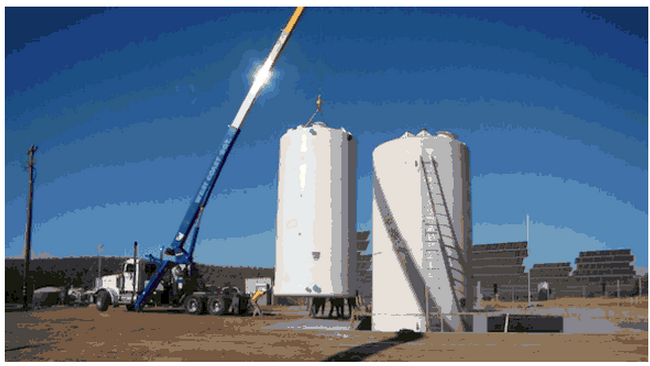Flow battery manufacturer, EnerVault, has recently announced that it is close to commissioning its first commercial flow battery-based energy storage system in California, USA. The Global Cleantech 100 listed company has also suggested that its flow battery costs will be competitive.
According to the US Department of Energy’s (DOE) latest report (pdf) on grid energy storage, the “magic number” for capital costs for energy storage must be $250/kWh and LCOE (levelised cost of energy) must be $0.20/kWh for storage technologies to be competitive. Without revealing specific cost figures, EnerVault suggests that capital costs for the battery will be “well below” this, making it “competitive on an LCOE basis” with Californian peaking natural gas power plants.
The current project, located in Turlock, California, will provide 250 kilowatts of power for four hours to Pacific Gas & Electric. The flow battery will be co-located with a PV system and a water pump as seen in the image below. The project was supported by the DOE’s storage demonstration program under the Obama government’s stimulus package, which provided $4.7 million in assistance.
 Image via EnerVault
Image via EnerVault
Flow batteries convert chemical energy into electricity by pumping electrolytes through a stack of electrochemical cells. Most flow battery technologies have limits on the level that the battery can be charged and discharged (referred to as the state-of-charge range). To overcome this, EnerVault “Engineered Cascade” technology has an optimised arrangement of the cell stacks, allowing the battery to operate in a broader state-of-charge range.
EnerVault’s flow battery technology uses iron-chromium electrolytes, which are safer and less acidic than vanadium, the chemical typically used in flow batteries. Being universally abundant elements, iron-chromium electrolytes are also less expensive, a common consideration for other chemistries being researched for flow batteries.
However, the net efficiency of the system is only 60% – significantly lower than 75% and 85% that other aqueous liquid electrolyte battery makers claim. In comparison, Li-ion batteries are over 80% efficient.
Moreover, flow batteries require the use of pumping systems to circulate electrolytes – a potential reliability issue. This is highlighted by AES, a leading developer of storage systems with no preference for specific technologies, who mentioned that they prefer “sealed batteries” like lithium-ion and are sceptical about new battery companies without a “strong track record” in reliability.
EnerVault admits that reliability will only be proven when the Turlock project is commissioned and has been operating long enough to test those projections; however, they are optimistic. They expect the hydraulic pumping system to last several thousand hours and stress that the system is easily replacable, with the mild nature of the chemicals used further improving battery life.
EnerVault has also been running and monitoring a laboratory-scale 30kW system and remains confident about the commercial project. “We continue to match our models”, claims Jim Pape, EnerVault’s CEO, referring to the forecasted performance of the project. “We’re really on the right track and we’re going to be well below the DOE target” for cost, he added.
At 250kW of capacity, EnerVault’s first commercial project is significantly smaller than some of the biggest vanadium flow batteries in operation today. But it’s the biggest iron-chromium flow battery in the world “by a factor of ten” in energy delivery, said EnerVault Chief Strategy Officer, Craig Horne.
In an industry with limited commercial deployment and field testing, EnerVault’s flow battery will be another step toward better understanding the cost, reliability and energy delivery capabilities of the technology.
Top image via EnerVault
© 2014 Solar Choice Pty Ltd
- Future of Utilities – Part 1: The death of base-load generators - 11 September, 2014
- Sharp enters energy storage market with SmartStorage - 18 August, 2014
- Phinergy extends electric car range with metal-air battery technology - 13 August, 2014